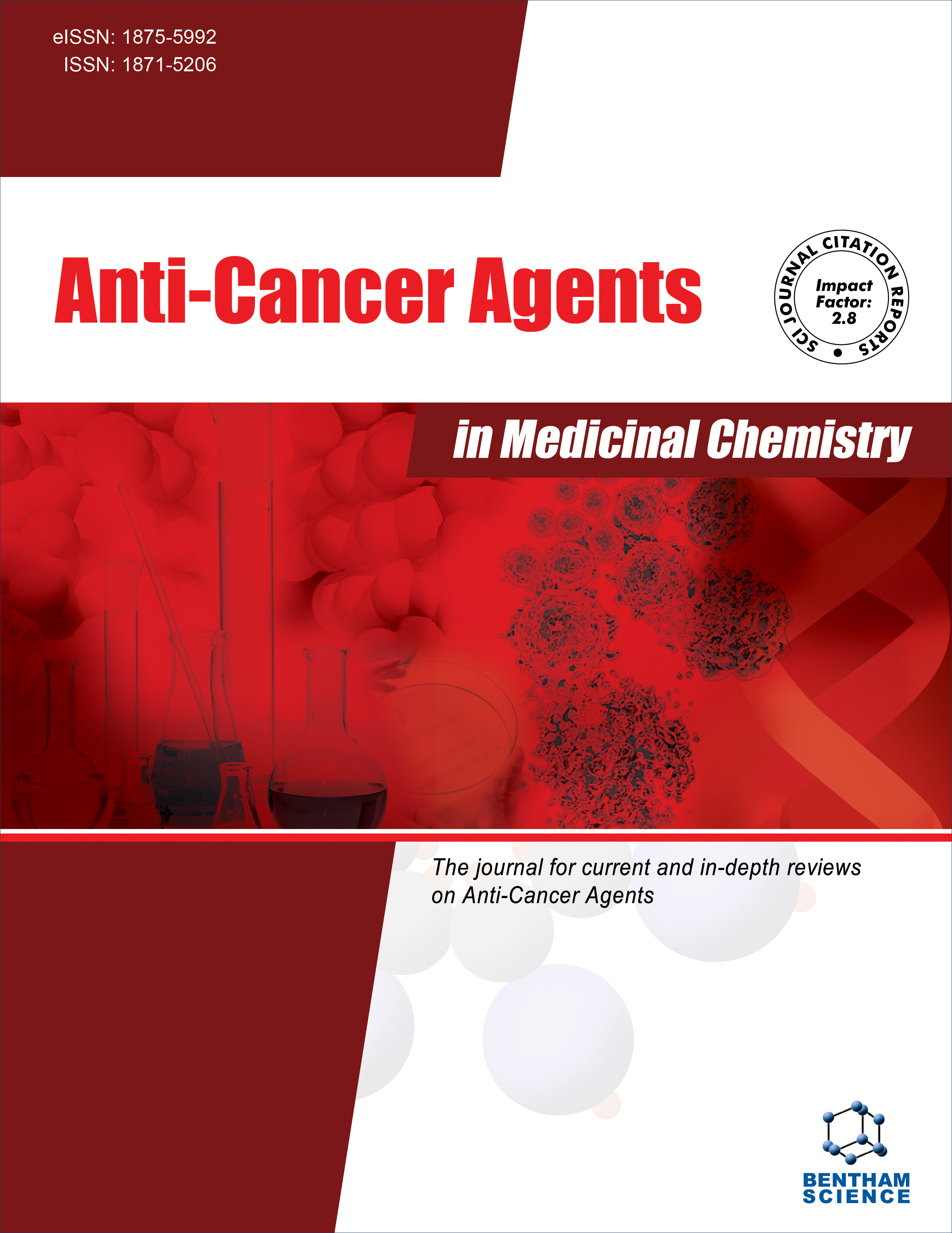- Home
- A-Z Publications
- Anti-Cancer Agents in Medicinal Chemistry (Formerly Current Medicinal Chemistry - Anti-Cancer Agents)
- Previous Issues
- Volume 22, Issue 19, 2022
Anti-Cancer Agents in Medicinal Chemistry (Formerly Current Medicinal Chemistry - Anti-Cancer Agents) - Volume 22, Issue 19, 2022
Volume 22, Issue 19, 2022
-
-
Heterocyclic Compounds: Importance in Anticancer Drug Discovery
More LessAuthors: Naresh Kumar and Nidhi GoelCancer, a crucial global health problem, is characterized by abnormal cell division and uncontrolled growth. According to WHO, cancer is the second leading cause of global deaths and accounted for approximately 9.6 million deaths or one in six deaths in 2018. The National Cancer Registry Programme Report 2020, released by the ICMRIndia, estimated that there would be 13,90,000 cases of cancer in India in 2020 Read More
-
-
-
Naturally Occurring O-Heterocycles as Anticancer Agents
More LessAuthors: Satya K. Avula, Biswanath Das, Rene Csuk and Ahmed Al-HarrasiCancer is a leading cause of death worldwide. Proper efficient drugs are required to treat this deadly disease. Natural products have long been a vital source of anticancer agents and they have generated various “lead compounds” suitable for drug developments. With the recent advancement of chemical synthesis and bioevaluation techniques, these lead compounds of natural origins have been utilized for the pr Read More
-
-
-
Discovery, Development and Design of Anthocyanins-Inspired Anticancer Agents: A Comprehensive Review
More LessMother Nature is an indispensable source of bioactive natural products. Bioactive secondary metabolites have played a crucial role in the drug development and discovery process; mainly, anticancer and antibiotic molecules are extensively enriched with molecules of natural origin. Anthocyanins are water-soluble secondary metabolites found in most species in the plant domain, especially flowers, fruits, and tubers. Read More
-
-
-
Current Developments in the Pyran-Based Analogues as Anticancer Agents
More LessAuthors: Parul Grover, Monika Bhardwaj, Lovekesh Mehta, Garima Kapoor and Pooja A. ChawlaHeterocyclic compounds offer an enormous area for new lead molecules for drug discovery. Till today, efforts are being continuously made to find appropriate treatment for the management of the deadly disease of cancer. Amongst the large number of heterocycles that are found in nature, heterocycles having oxygen obtained noteworthy attention due to their distinctive and pharmacological activities.‘Pyran’ is one of the m Read More
-
-
-
Design and Development of Triazole Derivatives as Prospective Anticancer Agents: A Review
More LessAuthors: Harshita Sachdeva, Mohammad Saquib and Kumud TanwarBackground: In recent years, there has been a crucial need for the design and development of novel anticancer drugs that can lessen the serious health problems and unwanted side effects associated with currently used anticancer drugs. The triazole nucleus is well-recognized to possess numerous pharmacological activities, including anticancer, as revealed by various investigations on anticancer drugs and the latest rese Read More
-
-
-
Synthesis and Anti-Cancer Applications of Benzimidazole Derivatives - Recent Studies
More LessAuthors: Yogesh K. Tyagi, Geetan jali and Ram SinghBackground: Cancer is a life-threatening disease. Anti-cancer drugs are the focus of research. The heterocyclic molecules like benzimidazole occupy a central position in searching for novel and effective anti-cancer drugs. The medicinal chemists designed and synthesized several benzimidazole derivatives and conjugates to evaluate them as potential anti-cancer agents. Objective: The purpose of this compilation o Read More
-
-
-
A Comprehensive Review on Journey of Pyrrole Scaffold Against Multiple Therapeutic Targets
More LessHeterocyclic compounds are that type of substances that are deeply intertwined with biological processes. Heterocycles are found in about 90% of commercially available medicines. In medicinal chemistry, finding new synthetic molecules with drug-like characteristics is a regular problem, which triggered the development of pharmacological molecules, the majority of which are based on N-heterocyclic motifs. Among the heteroc Read More
-
-
-
In vitro Antiproliferative Properties of Lipophililic-Acid Chelating Fluoroquinolones and TriazoloFluoroquinolones with 7-dihaloanilinosubstitution
More LessAuthors: Tasneem Hallaq, Yusuf Al-Hiari, Violet Kasabri, Rabab AlBashiti, Sundus AlAlawi and Ahmad TelfahBackground: Incidence rates and prevalence of cancer are substantially high globally. New safe therapeutic drugs are endorsed to overcome the high toxicity and poor safety profile of clinical anticancer agents. Objective: As antineoplastic Vosaroxin is a commercial fluoroquinolone (FQ), we hypothesize that superlative antiproliferation activity of lipophilic FQs/TFQs series correlates to their acidic groups and C8-C7 ethylene di Read More
-
Volumes & issues
-
Volume 25 (2025)
-
Volume 24 (2024)
-
Volume 23 (2023)
-
Volume 22 (2022)
-
Volume 21 (2021)
-
Volume 20 (2020)
-
Volume 19 (2019)
-
Volume 18 (2018)
-
Volume 17 (2017)
-
Volume 16 (2016)
-
Volume 15 (2015)
-
Volume 14 (2014)
-
Volume 13 (2013)
-
Volume 12 (2012)
-
Volume 11 (2011)
-
Volume 10 (2010)
-
Volume 9 (2009)
-
Volume 8 (2008)
-
Volume 7 (2007)
-
Volume 6 (2006)
Most Read This Month
Article
content/journals/acamc
Journal
10
5
false
en


